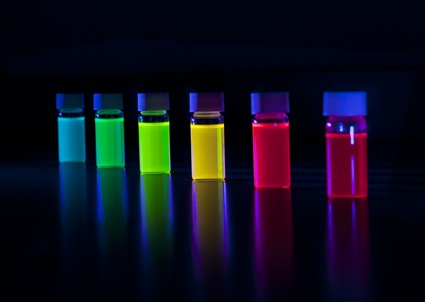The Pain Points and Promise of Perovskite Quantum Dots
Quantum dots are nanoscale semiconducting materials with distinctive optical qualities. Researchers have been particularly interested in building quantum dots from perovskites, a group of compounds that share a unique crystalline structure.
The perovskite quantum dots available from Avantama have shown significant promise for a range of optical technologies, including display technologies. Their essential optoelectronic qualities are very distinctive and of great interest to scientific researchers, particularly in the form of perovskite quantum dots.
With their distinctive crystalline structure, perovskite quantum dots have multiple advantages over other kinds of quantum dots, such as having bright photoluminescence in the visible part of the spectrum with a narrow bandwidth, and an emission wavelength can be altered by adjusting both their scale and composition. They also radiate much faster than quantum dots made from other materials.

Using Perovskite Quantum Dots in Display Technology
Perovskite quantum dots are well suited for use in display technology because they exceptionally brilliant and fast-emitting light sources. By changing chemical composition and structure, scientists have also succeeded in generating a wide variety of perovskite quantum dots capable of producing all the colors of the visible spectrum.
A recent study published in the journal Nature revealed why perovskite quantum dots made with cesium lead halide are much faster than other types of quantum dots. When a photon is used to excite perovskite quantum dots, an electron exists in the crystal lattice and leaves behind an electron-hole pair in an excited energy state. If the electron-hole pair goes back to its ground state, light is emitted.
While some quantum dots can enter a ‘dark state’ where the electron-hole pair doesn’t immediately revert to its ground state, the most-likely excited state of cesium lead halide quantum is not a dark state, the study team found. This is the reason these perovskite quantum dots shine too quickly and brilliantly.
Coming Soon: A More Stable Perovskite Quantum Dot
While perovskite quantum dots hold significant promise, they have stability issues related to air, heat, light, and water. Last year, however, a team of scientists from the Ecole Polytechnique Federale de Lausanne in Switzerland developed a fabrication technique that led to a new type of perovskite quantum dot that is much more stable, according to a paper published in the journal Angewandte Chemie International Edition.
The new method is based on the use of atomic layer deposition, a technique commonly used to create ultra-thin films with highly uniform structures. The researchers used atomic layer deposition to cover the perovskite quantum dots with an alumina matrix. This shell provides a gas and ion diffusion barrier that makes the quantum dots more stable against air, light, temperature and humidity.
The team utilized many characterization tactics to track the nucleation and growth of the alumina matrix over the exterior of the perovskite quantum dot. The team found that the interaction between the deposition precursor and the dot exterior is essential in uniformly coating the dots while protecting their optoelectronic qualities.
The study team said their work could have a massive impact on technology research by enabling the more essential study of perovskite quantum dots, which must be stable enough to undergo test procedures. Furthermore, the research increases the number of possible applications.
Perovskite Quantum Dots from Avantama
Avantama has years of experience in producing and developing perovskite quantum dots for a range of electronic applications. If you would like any more information about our perovskite quantum dots, please contact us.